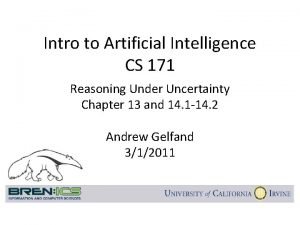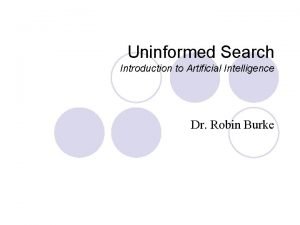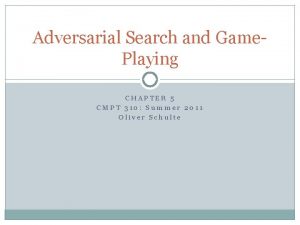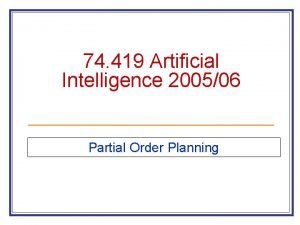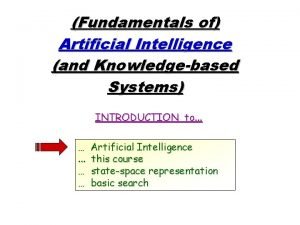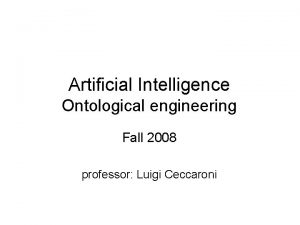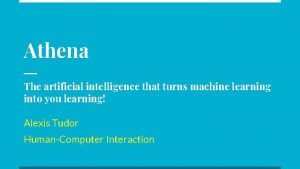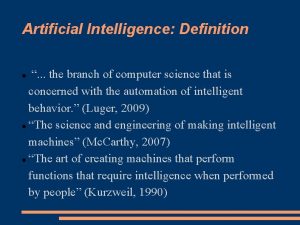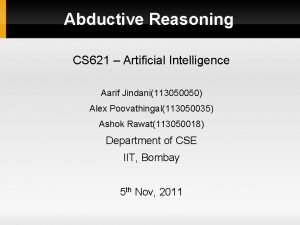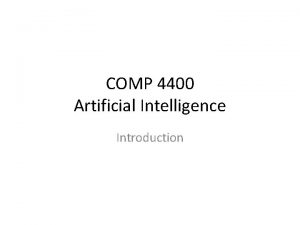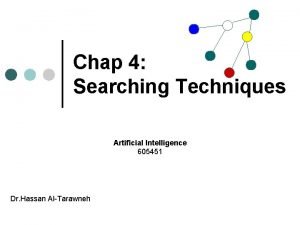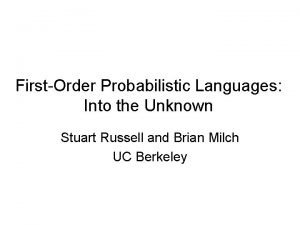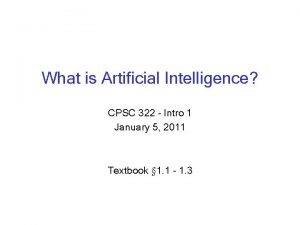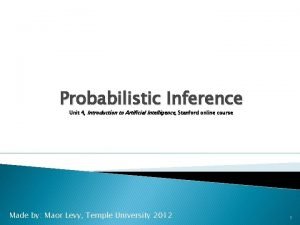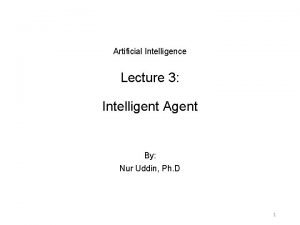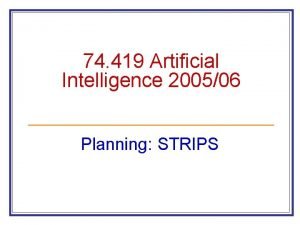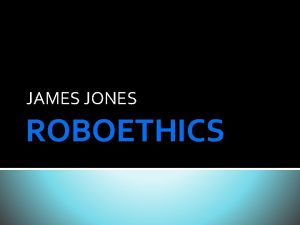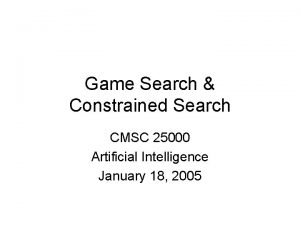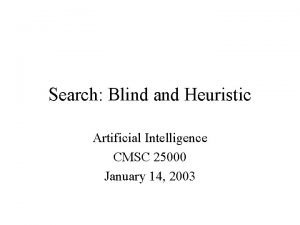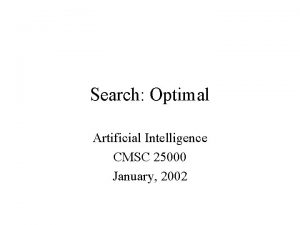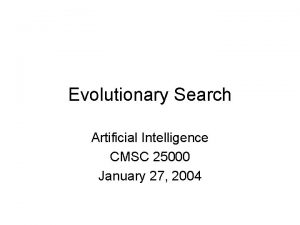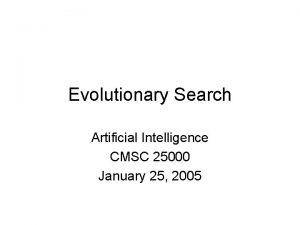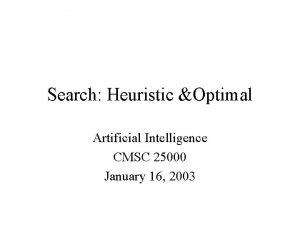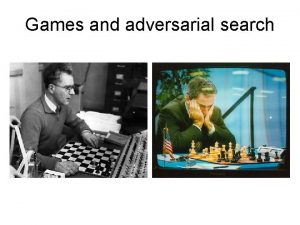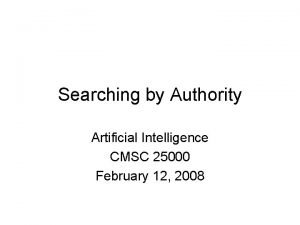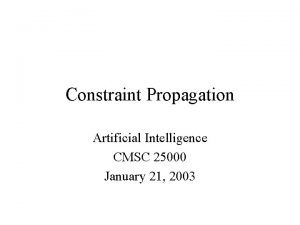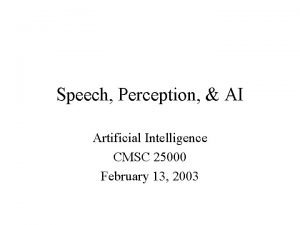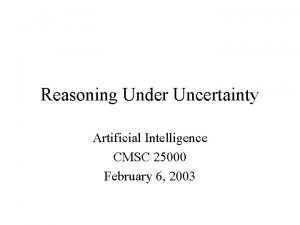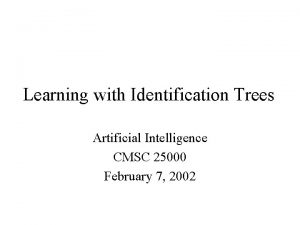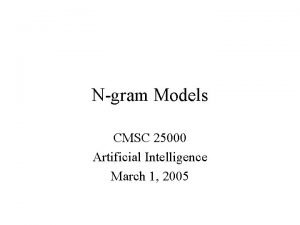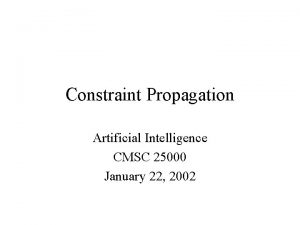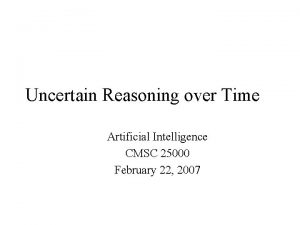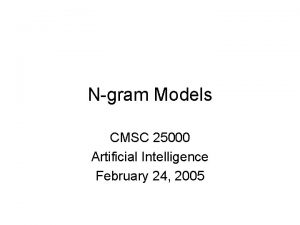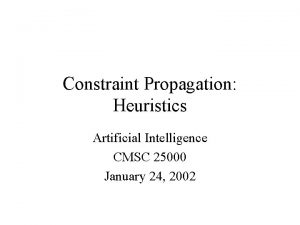Search Games Adversarial Search Artificial Intelligence CMSC 25000



























































- Slides: 59

Search: Games & Adversarial Search Artificial Intelligence CMSC 25000 January 28, 2003

Agenda • Game search characteristics • Minimax procedure – Adversarial Search • Alpha-beta pruning: – “If it’s bad, we don’t need to know HOW awful!” • Game search specialties – Progressive deepening – Singular extensions

Games as Search • Nodes = Board Positions • Each ply (depth + 1) = Move • Special feature: – Two players, adversial • Static evaluation function – Instantaneous assessment of board configuration – NOT perfect (maybe not even very good)

Minimax Lookahead • Modeling adversarial players: – Maximizer = positive values – Minimizer = negative values • Decisions depend on choices of other player • Look forward to some limit – Static evaluate at limit – Propagate up via minimax

Minimax Procedure • If at limit of search, compute static value • Relative to player • If minimizing level, do minimax – Report minimum • If maximizing level, do minimax – Report maximum

Minimax Example 2 MAX 2 1 MIN MAX

Alpha-Beta Pruning • Alpha-beta principle: If you know it’s bad, don’t waste time finding out HOW bad • May eliminate some static evaluations • May eliminate some node expansions • Similar to branch & bound

Simple Alpha-Beta Example 2 >=2 MAX 2 <=1 MIN MAX 1

Alpha-Beta Detailed Example

Alpha-Beta Detailed Example

Alpha-Beta Detailed Example

Alpha-Beta Detailed Example

Alpha-Beta Detailed Example

Alpha-Beta Detailed Example

Alpha-Beta Detailed Example

Alpha-Beta Detailed Example

Alpha-Beta Detailed Example

Alpha-Beta Detailed Example

Alpha-Beta Detailed Example

Alpha-Beta Detailed Example

Alpha-Beta Detailed Example

Alpha-Beta Detailed Example

Alpha-Beta Detailed Example

Alpha-Beta Detailed Example

Alpha-Beta Detailed Example

Alpha-Beta Detailed Example

Alpha-Beta Detailed Example

Alpha-Beta Detailed Example

Alpha-Beta Detailed Example

Alpha-Beta Detailed Example

Alpha-Beta Detailed Example

Alpha-Beta Detailed Example

Alpha-Beta Detailed Example

Alpha-Beta Detailed Example

Alpha-Beta Detailed Example

Alpha-Beta Detailed Example

Alpha-Beta Detailed Example

Alpha-Beta Detailed Example

Alpha-Beta Detailed Example

Alpha-Beta Detailed Example

Alpha-Beta Detailed Example

Alpha-Beta Detailed Example

Alpha-Beta Detailed Example

Alpha-Beta Detailed Example

Alpha-Beta Detailed Example

Alpha-Beta Detailed Example

Alpha-Beta Detailed Example

Alpha-Beta Procedure If level=TOP_LEVEL, alpha = NEGMAX; beta= POSMAX If (reached Search-limit), compute & return static value of current If level is minimizing level, While more children to explore AND alpha < beta ab = alpha-beta(child) if (ab < beta), then beta = ab Report beta If level is maximizing level, While more children to explore AND alpha < beta ab = alpha-beta(child) if (ab > alpha), then alpha = ab Report alpha

Alpha-Beta Pruning Analysis • Worst case: – Bad ordering: Alpha-beta prunes NO nodes • Best case: – Assume cooperative oracle orders nodes • Best value on left • “If an opponent has some response that makes move bad no matter what the moving player does, then the move is bad. ” • Implies: check move where opposing player has choice, check all own moves

Optimal Alpha-Beta Ordering

Optimal Ordering Alpha-Beta • Significant reduction of work: – 11 of 27 static evaluations • Lower bound on # of static evaluations: – if d is even, s = 2*b^d/2 -1 – if d is odd, s = b^(d+1)/2+b^(d-1)/2 -1 • Upper bound on # of static evaluations: – b^d • Reality: somewhere between the two – Typically closer to best than worst

Heuristic Game Search • Handling time pressure – Focus search – Be reasonably sure “best” option found is likely to be a good option. • Progressive deepening – Always having a good move ready • Singular extensions – Follow out stand-out moves

Progressive Deepening • Problem: Timed turns – Limited depth • If too conservative, too shallow • If too generous, won’t finish • Solution: – Always have a (reasonably good) move ready – Search at progressively greater depths: • 1, 2, 3, 4, 5…. .

Progressive Deepening • Question: Aren’t we wasting a lot of work? – E. g. cost of intermediate depths • Answer: (surprisingly) No! – Assume cost of static evaluations dominates – Last ply (depth d): Cost = b^d – Preceding plies: b^0 + b^1+…b^(d-1) • (b^d - 1)/(b -1) – Ratio of last ply cost/all preceding ~ b - 1 – For large branching factors, prior work small relative to final ply

Singular Extensions • Problem: Explore to some depth, but things change a lot in next ply – False sense of security – aka “horizon effect” • Solution: “Singular extensions” – If static value stands out, follow it out – Typically, “forced” moves: • E. g. follow out captures

Additional Pruning Heuristics • Tapered search: – Keep more branches for higher ranked children • Rank nodes cheaply • Rule out moves that look bad • Problem: – Heuristic: May be misleading • Could miss good moves

Games with Chance • Many games mix chance and strategy – E. g. Backgammon – Combine dice rolls + opponent moves • Modeling chance in game tree – For each ply, add another ply of “chance nodes” – Represent alternative rolls of dice • One branch per roll • Associate probability of roll with branch

Expectiminimax: Minimax+Chance • Adding chance to minimax – For each roll, compute max/min as before • Computing values at chance nodes – Calculate EXPECTED value – Sum of branches • Weight by probability of branch

Summary • Game search: – Key features: Alternating, adversarial moves • Minimax search: Models adversarial game • Alpha-beta pruning: – If a branch is bad, don’t need to see how bad! – Exclude branch once know can’t change value – Can significantly reduce number of evaluations • Heuristics: Search under pressure – Progressive deepening; Singular extensions
 Optimal decisions in games in artificial intelligence
Optimal decisions in games in artificial intelligence Optimal decisions in games in artificial intelligence
Optimal decisions in games in artificial intelligence Informed and uninformed search in artificial intelligence
Informed and uninformed search in artificial intelligence Uninformed search examples
Uninformed search examples Uninformed search in artificial intelligence
Uninformed search in artificial intelligence State space in ai
State space in ai Adversarial search problems uses
Adversarial search problems uses 750000/25000
750000/25000 Budak dilli
Budak dilli 750000/25000
750000/25000 Caracteristicas de ciliados
Caracteristicas de ciliados 25000-7000
25000-7000 Iso 25000
Iso 25000 Partial order planning in artificial intelligence
Partial order planning in artificial intelligence Augmented grammar in ai
Augmented grammar in ai Solving problems by searching artificial intelligence
Solving problems by searching artificial intelligence Artificial intelligence chapter 1
Artificial intelligence chapter 1 Peas for interactive english tutor
Peas for interactive english tutor Coordinated plan on artificial intelligence
Coordinated plan on artificial intelligence 15-780 graduate artificial intelligence
15-780 graduate artificial intelligence Fundamentals of artificial intelligence
Fundamentals of artificial intelligence Ontological engineering in artificial intelligence
Ontological engineering in artificial intelligence Athena machine learning
Athena machine learning Ai is a branch of computer science
Ai is a branch of computer science Artificial intelligence sop
Artificial intelligence sop Searching for solutions in artificial intelligence
Searching for solutions in artificial intelligence Rule based deduction system in artificial intelligence
Rule based deduction system in artificial intelligence Snapdragon artificial intelligence
Snapdragon artificial intelligence Artificial intelligence
Artificial intelligence Cse 571 artificial intelligence
Cse 571 artificial intelligence Artificial intelligence leadership
Artificial intelligence leadership Agent in artificial intelligence
Agent in artificial intelligence Best for search
Best for search Artificial intelligence: a modern approach
Artificial intelligence: a modern approach 15-780 graduate artificial intelligence
15-780 graduate artificial intelligence References for artificial intelligence
References for artificial intelligence Artificial intelligence devices
Artificial intelligence devices Pxdes
Pxdes Cpsc 322: introduction to artificial intelligence
Cpsc 322: introduction to artificial intelligence Partitioned semantic nets in artificial intelligence
Partitioned semantic nets in artificial intelligence Artificial intelligence chapter 1
Artificial intelligence chapter 1 15-780 graduate artificial intelligence
15-780 graduate artificial intelligence Steps toward artificial intelligence
Steps toward artificial intelligence Knowledge manipulation in ai
Knowledge manipulation in ai Csci-b 551 elements of artificial intelligence
Csci-b 551 elements of artificial intelligence Artificial intelligence devices
Artificial intelligence devices Types of artificial intelligencel
Types of artificial intelligencel Artificial intelligence applications institute
Artificial intelligence applications institute Artificial intelligence devices
Artificial intelligence devices Inference by enumeration in artificial intelligence
Inference by enumeration in artificial intelligence 15 780
15 780 Omniscience in artificial intelligence
Omniscience in artificial intelligence Strips planning
Strips planning Uas kecerdasan buatan
Uas kecerdasan buatan Conceptual graph in artificial intelligence tutorial
Conceptual graph in artificial intelligence tutorial Artificial intelligence the next digital frontier
Artificial intelligence the next digital frontier Bin zaid face
Bin zaid face Ethics of artificial intelligence
Ethics of artificial intelligence What is utility based agent
What is utility based agent Hbr machine learning
Hbr machine learning
